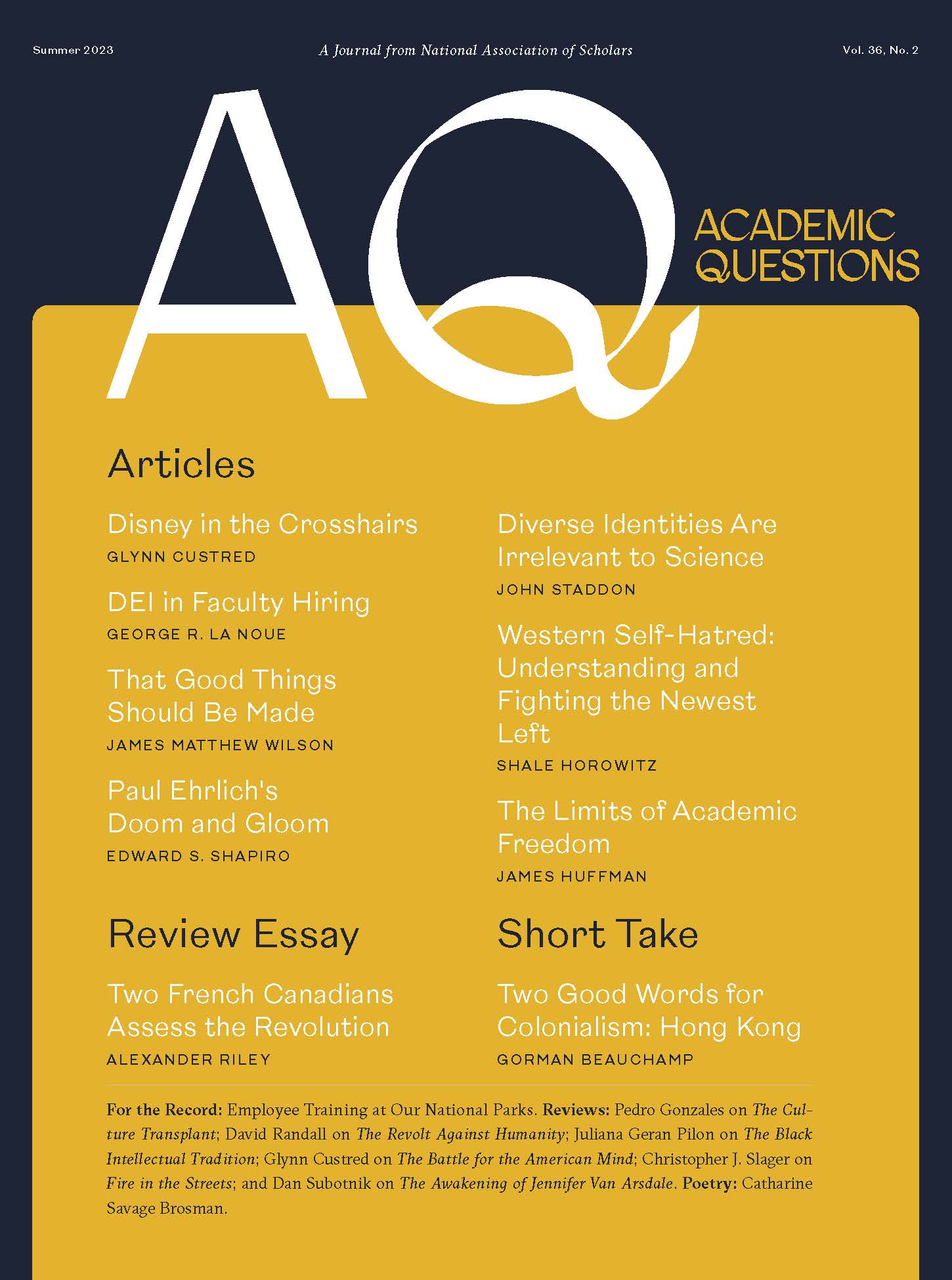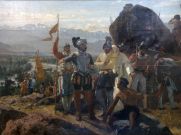Contemplating a Good Thing
At the very end of the twentieth century, in the pages of The New Yorker, the seventy-eight-year-old American poet, Richard Wilbur, published his poem “Mayflies.”1 The poem depicts the poet’s walking through a “somber forest, when the sun was low,” and coming upon a “mist” of “quadrillions” of the short-lived insects named in the title. The poet is first struck by the insects as an uncanny enchantment, a kind of faerie light happened upon by pure fortune, but as he attends more closely he sees that they constitute “no muddled swarm,” but a kind of ballet, a “figured scene,” a “cloth of gold” and likens them to the “fine pistons of some bright machine.” The first stanza details the encounter, the second seeks to describe their movements, and the third then turns from this natural and instinctive spectacle to the conscious, alienated subjectivity of the poet:
Watching those lifelong dancers of a day
As night closed in, I felt myself alone
In a life too much my own,
More mortal in my separateness than they—
Unless, I thought, I had been called to be
Not fly or star
But one whose task is joyfully to see
How fair the fiats of the caller are.
To see Wilbur’s stanzaic form whole is to notice a kind of conceptual rhyme. Like the flight of the mayflies, it is itself intricately ordered: eight lines in envelope rhyme (abba) followed by cross rhyme (cdcd), with three “couplets” of iambic pentameter set apart by one line of trimeter and one line of dimeter. Nature’s beautiful form is imitated by the poet’s artificial form. The similes by which he tries to describe the movement of the flies, in the second stanza, find an echo in the figures of speech in this third stanza, as it describes the poet’s artifice-making mind. The mayflies are “lifelong dancers of a day,” in the sense of living for only one day, and he sees them in the “night” of forest gloom, but also anticipates their night, their imminent death; the antithesis of day and night becomes a contrast of life and death. Whereas their life is all cooperation in a form that transcends them, both in quantity and in beauty, the poet suddenly feels his life a thing of individualized solitude. Alienated from the world simply by his consciousness, his thinking about it, he senses his own mortality—as if thought were pointless and so his life absurd.
Consciousness is a burden that alienates him from the natural unity and order of the flies—which with its circular orbit displays at the microcosmic level the movement of the planets and the stars, the cosmos writ large. Without making this analogy explicit, the poet assumes it and contrasts his consciousness with “fly” and “star” alike. The unstated analogy is itself a product of consciousness, of the capacity to see things, know them, and then to fit that particular knowledge into the universal whole we call wisdom.
The poem had turned from nature to subjectivity, and now it turns subjectivity around for further examination. Yes, the mind isolates us from pure natural circulations with their cosmic beauty, but the mind also takes stock of its own activity and realizes that it too has a natural purpose. The beauty of nature can be called beautiful only if it is known. Our minds are by nature intended to be the knowers of nature; they are to take joy in seeing, which is to draw truth (seeing) and goodness (joy) together in the contemplation of beauty (the circling order of all things).
The poem suggests that contemplation is itself a kind of circle. Rather, it is a hierarchy of four concentric circles analogous to the circulation of the flies and stars: first, the poet’s contemplation of the flies; second, the poet’s reflection on his own consciousness; third, the reader’s contemplation of the poem as work of art; and fourth, a higher and more mysterious contemplation, indicated only in the final line of the poem: “How fair the fiats of the caller are.” Our minds contemplate receptively: we come to know what already exists. But another mind, the divine mind, calls existent things into being, by “fiat.” Fiat is the word by which God commands all things into being in the Vulgate translation of the book of Genesis. All that has been created is thus a “fair” thing, a good thing, that leads us not only to the contemplation of the order of things but beyond them to their source in the first “caller.” From matter (the flies), to spirit (subjectivity) and from making (the poem), to creation (the work of the divine fiat), the poem suggests that reality as such is ordered to the contemplation of beauty and poetry plays a kind of mediating role between the pure material order of nature and the purely spiritual order of the divine mind. Mortal creatures that we are, we participate in the death of the mayflies but also the calling into being of the spirit.
The Persistence of Good Things
Wilbur’s is a marvelous poem and a rare one because of its great achievement. But in some ways it is a typical poem. The great poet and critic, Yvor Winters, who was at the height of his career just as Wilbur was beginning his, wrote in defense of much of modern poetry as exemplary of the “Post-Symbolist Method.”2 Winters was a brilliant defender of the poetry of the English Renaissance, especially the plain style, didactic poems of the sixteenth century (such as those of Thomas More, Barnaby Googe, and George Gascoigne) that preceded the arrival and dominance of the ornate Petrarchan style in the seventeenth. Poetry was, for him, a perception of order in reality and a means to order in the soul. But, a modern poet himself, he had great sympathy for the departures from tradition of modern art that had been made possible by the rise of romanticism and culminated in the works of Joyce, Eliot, and Pound. Post-Symbolism, as he used the term, referred to those poets who followed the romantics in expanding the subject-matter of poetry and who followed them also in exploring the “associations” of the mind. Such poets, however, also followed the earlier achievement of the Renaissance in bringing rational “control” to the mind’s associations.3 In brief, their poems began in the depiction of a concrete scenario, then moved by controlled association toward understanding of its meaning and concluded with a moral resolution of will in response to that meaning. The poetry of Winters’ day, including the early Wilbur, was exemplary of this method. In “Mayflies” we see a late example of it.
Some critics have described lyrics of this variety as “mid-century formalism,” and I have elsewhere called it the style of “late modernism.”4 Such terms describe an age in English and American poetry that felt the influence of Eliot and other modernists, but sought to recover the discipline, form, and beauty of the longer poetic tradition. I attend to Wilbur’s great success in the style here to show, first, that not all modern poetry departed utterly from the traditions of verse, and second, that great literary achievements have continued to be made in that tradition. Wilbur’s poem on the cusp of the new century (June 1999) suggests continuity rather than rupture.
The Loss of Good Things
The course of Wilbur’s life, however, does suggest a rupture. When he began publishing poems in the years following the Second World War, he was considered an exceptionally talented but otherwise typical poet of his day. As the decades passed, however, he came to appear as an unusual figure, persisting in the practice of form, meter, and contemplative intelligence, even as other poets abandoned these things and came to think of poetry as a kind of art where even the following could count as a poem:
Bananas are an example.5
Winters celebrated the variety of modern poetry’s attentions, but practiced and defended the use of meter and rhyme and—even more controversial—its identity as a rational means of contemplation. The poet Robert Pinsky, a student of Winters, attempted to maintain the principles of his master while also developing a theory of poetry that could find room for the absurdist fragment just quoted. Many poets in our day would have no difficulty recognizing “Bananas are an example” as a poem, but would look upon Wilbur’s “Mayflies,” and find it as alien an object as the poet initially finds the dance of mayflies in the woods. If that is a poem, they would say, it has nothing to do with them.
This transformation of the understanding of poetry has never been general. Many publishing and award-littered contemporary poets might not recognize Wilbur’s work as a poem, but it is still possible to find “average people” who do not think something is a poem unless it rhymes. That folk sense has remained largely undisturbed, in part because it is right, in part because human nature is dogged, and in part because people now seldom encounter poetry of any kind in their lives and so have no occasion to reflect upon old assumptions.
Nearly a decade ago, I wrote a book defending poetry as a living tradition, as exemplified by poets such as Wilbur, from its professional imposters.6 There, I argued that the mainstream of American poetry was now divisible into three basic kinds. The most traditional contemporary poets wrote first-person reflections in a free verse line. Robert Hass, our Poet Laureate from 1995-1997 (and also a former Winters student), Robert Pinsky, Poet Laureate from 1997-2000, and Charles Wright, winner of the Pulitzer Prize and the National Book Award, were exemplary of this practice. Such poets maintained the contemplative dimension of poetry we find in Wilbur, while discarding much else.
A second stream were heirs of the French surrealists who specialized in creating the appearance of metaphors by simply layering odd images and disjointed phrases on the page. The poet David Yezzi, a critic of this practice, dismissed them as “unrealists.”7 In a superficial and impoverished way, such poets still maintained the tradition of the trope, of nonliteral significance signaled by a concrete expression, but in other respects they broke with it. They surrendered verse form, but also the idea of the lyric poem as a work of unified, intelligent expression and an object of contemplation.
A third stream, and one farthest removed from the tradition, was that of the avant-garde “language” poets. Such poets paid inadvertent lip service to poetic form insofar as the typographical shape of the poem on the page was treated as a thing of great importance, and they paid ironic tribute to the power of poetry as a spiritual discipline by conceiving of their work primarily as a political defiance of the totalizing uniformity of civilization. But their work did not simply break with poetic form, it often broke down language to a chaos of phonemes. Here a few exemplary lines, chosen at random, from Lyn Hejinian:
in a full and extensive solitude
I do not understand what I could possibly beat
a sending meets a point please
a name of coincidence meets
quantity of auto normal safety of respect8
All three of those streams had something in common with poetry as traditionally understood, but their alienation from that tradition was nonetheless patent. Pinsky’s The Situation of Poetry, published decades ago, and Robert Hass’s ironically titled A Little Book on Form, published only a few years ago, make the strongest possible case for the continuity of even the most radical contemporary poetry with the long poetic tradition.9 The case mostly fails, as the special pleading and spine-cracking contortions of argument necessary to make it leave one with a set of definitions so broad as to be useless. It is, nonetheless, interesting to note that they took the making of the case as something worth doing. Free verse reflections, it seemed, depended upon their derivation from the older tradition to justify themselves. Poets in the other two streams are not similarly troubled by the discontinuity between their practices and those of the poets of history. Indeed, the break is the whole point.
From Artistic Goodness to Identity Politics
While all three of these kinds of poetic practice were dominant at the time of my writing, and while poets of their type are still writing today, in retrospect, my taxonomy feels too superficial. It gives too little weight to the more pervasive phenomenon that guides the practice of poetry in our day—a phenomenon that has hijacked nearly all the arts, in fact. What is that phenomenon? The poet Timothy Steele sums it up well here:
Today, in the absence of agreed upon standards of versification, poetry often is judged exclusively with respect to its intentions or subject matter. Frequently, poets characterize themselves or are characterized by critics according to political views or ethnic backgrounds or sexual preferences. Poets are thus classified as “ecologists,” “feminists,” “gay activists,” “native Americans,” “black poets,” and so forth . . . It is good that poets should write of issues and causes that they believe are important. Classifying poetry by the causes it addresses, however, trivializes meter: the practice confuses what is extrinsic to poetic structure with what is intrinsic to it.10
The imposition of the extrinsic to subordinate the intrinsic, the imposition of the identity of the poet to subordinate the poem, the imposition of a system of patronage, a reward system, called identity politics, to eliminate all other interests and concerns: this, alas, is the most conspicuous feature of contemporary poetry. Remarkably, Steele wrote these lines in 1990, more than three decades ago. What they describe is more pervasive now by orders of magnitude than it was then.
There is of course no point in arguing against this phenomenon. Those who advance it could only greet discussion of prosody, poetic form, aesthetic contemplation, or wisdom with incomprehension. For such minds, these things are either irrelevant to the cause or dangerous “ideologies” to be opposed. For those not already beholden to such a vision, however, an apology for poetry can be made, and it should feel free simply to leave out of account the world of “identity politics.” The aim would be not to counter it, but to build up a lively literary culture as an alternative to it and one that can flourish apart from it.
On the whole, the poetic culture mired in identity politics survives only in those state-subsidized redoubts of the university and public granting agencies. It does have its popular expressions, however, and these are worthy of note. The last several years have seen the rise of writers, such as Rupi Kaur, who post short free verse lyrics on social media. They are sometimes called “instapoets.” The poems are melancholy to the point of mawkishness, expressing the kind of vaguely feminist, emotionally fragile sentiments likely to resonate with the feelings of adolescent girls, who are indeed the chief readership of such poems. What is fascinating about them is that their appearance—always in old typewriter font—betrays a sense of nostalgia for a time when the lyric poem was treated as a source of wisdom and consolation by a broad private readership.
Over the last two decades the redundantly named phenomenon of “spoken word” poetry has also achieved meaningful popularity. Its performances and competitions (“slams”) take place across the country; its single greatest moment of public recognition however has been the poet Amanda Gorman’s recitation of a poem at the inauguration of Joseph Biden. Gorman’s work, like that of many spoken word poets, retains hints of the practices of meter and rhyme—strained through hiphop and homiletics—that were all but universal until the advent of modernist free verse in the twentieth century. Gorman indeed rhymes frequently, if irregularly, and while her verse is unmetered it has the heavy cadences of the psalms. If the instapoets faintly recall poetry as a source of private wisdom, the spoken word poets remind us that poetry was once routinely declaimed at public functions. While it generally lacks steady craft or intellectual subtlety, it does approach something like a grand platform rhetoric.
The Goodness of Music and Rhetoric
The alternative literary culture to these phenomena already exists and indeed has flourished for decades, as the example of Wilbur’s poem should remind us. What is it we find in Wilbur’s poem and in that tradition writ large that is merely abandoned by a poetry of “identity,” but which is at least faintly echoed by the social media lyricists and the spoken word declaimers? The answer, I think, is twofold: music and rhetoric.
If we look back to the earliest poetry of the West outside of sacred scripture, that of Hesiod and Homer, we quickly notice two things. Ancient poetry was without exception recited with instrumental accompaniment. Poetry has its origin in song. This is one reason that it was written in meter and, later, in rhyme: to give the verses measurement and form that could be set to music. Despite this near identity of poetry with music, however, the ancients also saw it as a part of classical rhetoric. This was so, most obviously, because poetry depends on figural language—schemes and tropes—but also because, in measuring or metering a line, the poet was doing at a greater level of precision what rhetoricians always do: they were giving form and refinement to language.
Wilbur’s “Mayflies” is exemplary in both regards. The finely wrought stanzas, though naturally suitable for speech rather than song, nonetheless retain musical properties in the measured verses and in the sounding of the rhymes. The structure of the poem as a whole, however, is exemplary as a work of rhetoric, of carefully weighed and measured speech that leads the mind and informs the feelings simultaneously. Much of the poetry in our day has severed itself from the musical and rhetorical foundations of poetry, whether by refusing all regular order as does most free verse or by trying to dissever itself entirely from the coherence and intelligibility of refined speech.
Wilbur’s career reminds us, however, that there was a persistence of great poetry even during the inauspicious decades of the late twentieth century. His example led to the rise, in the 1980s, of the so-called New Formalists, of whom I will name just two. The poet Dana Gioia’s work, with its wide variety of forms, consistently reminds us of poetry’s origins in the enchantment of music. Another poet (mentioned above), Timothy Steele, has no less consistently shown, in verse and prose alike, the rootedness of poetry in classical rhetoric.
The achievement of the New Formalists, in time, inspired an entire generation of younger poets to return to meter, rhyme, and the clear but powerful order of refined speech. Such poets did so, not as a counter-revolution to be fought against the degradations of much contemporary poetry, but simply as a way of making good things. It is a minority tradition, an alternative literary culture. Nevertheless, our age has not only the memory of the exceptional achievement of Wilbur, but also a great number of practicing poets whose work is worthy of our attention and capable of leading us, as Wilbur’s poem does, from meditation on the things of this world, to meditation on the finely wrought poem, and on to meditation on the source and end of all things. Some good things continue to be made.
James Matthew Wilson, is Cullen Foundation Chair in English Literature and Professor of Humanities at the University of St. Thomas. He is also Director of UST’s MFA Program in Creative Writing, the Poet in Residence at The Benedict XVI Institute, and Poetry Editor of Modern Age. Wilson last appeared in AQ with “The Religion of Narcissism,” a review of Ernest J. Zarra’s When the Secular Becomes Sacred (2021) in the Winter 2022 issue.
1 Richard Wilbur, Collected Poems, 1943-2004 (New York: Harcourt, Inc., 2004), 36.
2 Yvor Winters, Forms of Discovery (Chicago: The Swallow Press, 1967), 251.
3 Winters, Forms of Discovery, 253.
4 See, Dana Gioia, Can Poetry Matter? (Saint Paul, MN: Graywolf Press, 2002), 225; Robert McPhillips, The New Formalism: A Critical Introduction (Charlotte, NC: Volcanic Ash Books, 2003); and James Matthew Wilson, “The American Poetic Tradition We Could Have Had,” Forma Review (https://formajournal.substack.com/p/the-american-poetic-tradition-we).
5 Robert Pinsky, The Situation of Poetry (Princeton: Princeton University Press, 1976), 87.
6 James Matthew Wilson, The Fortunes of Poetry in an Age of Unmaking Second Edition (Milwaukee, WI: Wiseblood Books, 2022).
7 Wilson, The Fortunes of Poetry in an Age of Unmaking, 177.
8 Lyn Hejinian, Writing Is an Aid to Memory (Los Angeles: Sun and Moon Press, 1996), Section 22.
9 Robert Hass, A Little Book on Form (New York: Harper Collins, 2018).
10 Timothy Steele, Missing Measures (Fayetteville: University of Arkansas Press, 1990), 290.
Photo by Hannah Olinger on Unsplash














